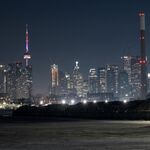TOareaFan
Superstar
@44north...in your map above the legend shows Sheppard as a light purple colour but your loop takes the green of the BD onto/across sheppard so there is no need for that colour in the map.
@44north...in your map above the legend shows Sheppard as a light purple colour but your loop takes the green of the BD onto/across sheppard so there is no need for that colour in the map.
Hmm. A "subway loop". Has anyone ever thought it'd be a good idea to loop B/D through STC and have it become the Sheppard Subway? So basically it'd cannibalize Sheppard, but offer a similar shape as Line 1 (but rotated 90deg).
That's a convenient excuse. Every part of Toronto is a minority. Didn't prevent Jack Layton from successfully leading the downtown charge against the TTC that killed the DRL in the 90s. And it's not like Scarborough politicians were in a position of strength when they began a road that eventually overturned a funded and approved LRT.I agree with the first part, but not the second. Downtown was always the minority. Yes, there was a brief period when downtown preservationists voiced opposition to the intensification/blockbusting that went along with subway-building during that era. But downtown had little power.
There was little justification for building the Downtown Relief Line in the 90s. It was a vanity project, like the Scarborough Subway.
Nope, it is not a vanity project
it is the inability to foresee future needs...
I said the DRL was a vanity project. Past tense.
Well how far into the future should we be considering when deciding to build infrastructure? The Network 2011 plan would've completed the DRL in about 2000, about 30 years before the line is expected to become necessary. I'd much rather delay the construction of the DRL by a few decades, than have the TTC forced to operate yet another expensive and underused rapid transit line.
Would have been higher ridership in the 1990s than the Scarborough Subway in the 2020s ... but after the 1991 recession, the DRL was no longer essential - but certainly it was never a vanity project.There was little justification for building the Downtown Relief Line in the 90s. It was a vanity project, like the Scarborough Subway.
Keep in mind the Network 2011 DRL was an ICTS line. I don't think I've seen any evidence that it was to be a standard heavy rail underground subway. And I believe all the preceding plans were for a streetcar subway or pre-metro.
Edit: so I guess what I was going to add was that an ICTS drl (or its streetcar-subway / Crosstown-style pre-metro predecessor) would've been more affordable than a heavy rail line. However either would've been quite intrusive had they gotten built (which I doubt would've happened, even if downtown politicos supported it).
I wonder what would be better: a 1990 skytrain line, or our current wait for a 2030 proper line.
I'd say wait. It would be difficult for ICTS to handle to passenger loads in the Yonge Relief Network Study.
The proposed Eglinton busway quickly morphed into a subway before its infamous death at the hands of the Harris government. Hard to imagine a 90s DRL wouldn't have been a standard subway if things had progressed. And, pre-Network 2011, there was a proposal floated at Metro Council in the early 80s to build a subway parallel to the DVP which, again, was ignored/rejected by downtown.Keep in mind the Network 2011 DRL was an ICTS line. I don't think I've seen any evidence that it was to be a standard heavy rail underground subway. And I believe all the preceding plans were for a streetcar subway or pre-metro.




